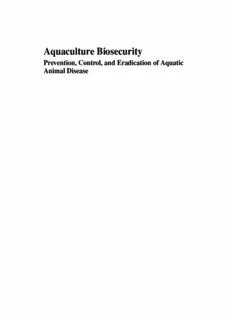Table Of ContentAquaculture Biosecurity
Prevention, Control, and Eradication of Aquatic
Animal Disease
Aquaculture Biosecurity
Prevention, Control, and Eradication of Aquatic
Animal Disease
Edited by
A. David Scarfe
AssistantDirector,ScientificActivities
AmericanVeterinaryMedicalAssociation
Schaumburg,Illinois,USA
Cheng-Sheng Lee
Director,AquacultureInterchangeProgram
OceanicInstitute,Waimanalo,Hawaii,USA
Patricia J. O’Bryen
ProjectManager,AquacultureInterchangeProgram
OceanicInstitute,Waimanalo,Hawaii,USA
(cid:1)C 2006BlackwellPublishing Firstedition,2006
Allrightsreserved
LibraryofCongressCataloging-in-PublicationData
BlackwellPublishingProfessional
2121StateAvenue,Ames,Iowa50014,USA Aquaculturebiosecurity:prevention,control,and
Orders:1-800-862-6657 eradicationofaquaticanimaldisease/editedbyA.David
Office:1-515-292-0140 Scarfe,Cheng-ShengLee,PatriciaJ.O’Bryen.–1sted.
Fax:1-515-292-3348 p. cm.
Website:www.blackwellprofessional.com Includesindex.
BlackwellPublishingLtd ISBN-13:978-0-8138-0539-9(alk.paper)
9600GarsingtonRoad,OxfordOX42DQ,UK ISBN-10:0-8138-0539-2(alk.paper)
Tel.:+44(0)1865776868 1.Fishes—Diseases—Prevention. 2.Shellfish—
BlackwellPublishingAsia Diseases—Prevention.
550SwanstonStreet,Carlton,Victoria3053,Australia I.Scarfe,A.David. II.Lee,Cheng-Sheng. III.O’Bryen,
Tel.:+61(0)383591011 P.J.(PatriciaJ.)
Authorizationtophotocopyitemsforinternalorpersonal SH171.A67 2006
use,ortheinternalorpersonaluseofspecificclients,is 639.8—dc22
grantedbyBlackwellPublishing,providedthatthebasefee 2005016403
of$.10percopyispaiddirectlytotheCopyrightClearance
Center,222RosewoodDrive,Danvers,MA01923.For Thelastdigitistheprintnumber:987654321
thoseorganizationsthathavebeengrantedaphotocopy
licensebyCCC,aseparatesystemofpaymentshasbeen
arranged.ThefeecodesforusersoftheTransactional
ReportingServiceareISBN-13:978-0-8138-0539-9;
ISBN-10:0-8138-0539-2/2006$.10.
Contents
Contributors vii
Preface xi
1 AquacultureBiosecurity:TheViewandApproachesoftheOIE(World
OrganisationforAnimalHealth)RegardingPreventionandControlof
AquaticAnimalDiseases 3
Eva-MariaBernoth
2 Biosecurity in Aquaculture: International Agreements and Instruments, their
Compliance,Prospects,andChallengesforDevelopingCountries 9
RohanaP.SubasingheandMelbaG.Bondad-Reantaso
3 RegionalApproachtoAquaticAnimalHealthManagement—Viewsand
ProgramsoftheNetworkofAquacultureCentresinAsia–Pacific 17
C.V.MohanandMelbaG.Bondad-Reantaso
4 Canada’sApproachtoAquaticAnimalBiosecurity:ExperienceandEvolution 31
SharonE.McGladderyandRichardE.Zurbrigg
5 TheU.S.Fish&WildlifeService’s“AquaticAnimalHealthPolicy”:Innovative
Approaches to Managing Diseases in Traditional and Special-Case Aquatic
Animals 55
ThomasA.Bell,J.ScottFoott,KathyClemens,SusanGutenberger,Ray
Brunson,JohnThoesen,RickNelson,NormHeil,JohnColl,andCrystal
Hudson
6 Wisconsin’sVeterinaryApproachtoFishHealth 69
MyronJ.Kebus
7 Harmonized, Standardized, and Flexible National Frameworks for Ensuring
DiagnosticDataandTestResultValidity:ACriticalNeedforAquaticAnimal
HealthDiagnosticSystemsandforBiosecurityinAquaculture 77
AnnL.Wiegers,JerryR.Heidel,andA.DavidScarfe
8 Disinfectants,Disinfection,andBiosecurityinAquaculture 91
G.RussellDannerandPeterMerrill
9 AquaticAnimalHealthSurveillance 129
F.ChrisBaldock,AngusR.Cameron,andNigelR.Perkins
vi Contents
10 BiosecurityattheFarmLevel—HowtoCreateaStateofMind 149
PaulHardy-Smith
11 Elements of an Aquatic Animal Health Program—Infectious Hematopoietic
NecrosisinFarmedAtlanticSalmoninBritishColumbia 155
GraceA.Karreman
12 APreliminaryInvestigationoftheRelationshipbetweenInfectedCage
RemovalSpeedandResultantSpreadofInfectiousSalmonAnemiaonAtlantic
SalmonFarmsinMaine,U.S.A.,andNewBrunswick,Canada 165
LoriGustafson,StephenEllis,LeighanneHawkins,MarkMoore,
TeresaRobinson,andDanMacPhee
Index 173
Contributors
F. Chris Baldock AusVet Animal Health Services, 19 Brereton Street, P.O. Box 3180,
SouthBrisbane,Queensland,4101,Australia.
Thomas A. Bell U.S. Fish & Wildlife Service, Division of the National Fish Hatchery
System,AquaticAnimalDrugApprovalPartnershipProgram,4050BridgerCanyonRoad,
Bozeman,Montana59715,USA.
Eva-Maria Bernoth Australian Government Department of Agriculture, Fisheries and
Forestry, Office of the Chief Veterinary Officer, GPO Box 858, Canberra, ACT 2601,
Australia.
MelbaG.Bondad-Reantaso FoodandAgricultureOrganizationoftheUnitedNations,
FisheriesDepartment,VialedelleTermediCaracalla,00100Rome,Italy.
Ray Brunson U.S. Fish & Wildlife Service, Olympia Fish Health Center, 3704 Griffin
LaneS.E.,Suite101,Olympia,Washington98501,USA.
AngusR.Cameron AusVetAnimalHealthServices,19BreretonStreet,P.O.Box3180,
SouthBrisbane,Queensland,4101,Australia.
Kathy Clemens U.S. Fish & Wildlife Service, Idaho Fish Health Center, P.O. Box 272,
Orofino,Idaho83544,USA.
JohnColl U.S.Fish&WildlifeService,LamarFishHealthCenter,P.O.Box155,Lamar,
Pennsylvania16848,USA.
G. Russell Danner Fish Health Laboratory, Maine Department of Inland Fisheries and
Wildlife,RuralRoute5,Box81,HatcheryRoad,Augusta,Maine03440,USA.
StephenEllis USDA-APHISVeterinaryServices,16DeepCoveRoad,Eastport,Maine
04631,USA.
J.ScottFoott U.S.Fish&WildlifeService,California-NevadaFishHealthCenter,24411
ColemanHatcheryRoad,Anderson,California96007,USA.
LoriGustafson USDA-APHISVeterinaryServices,16DeepCoveRoad,Eastport,Maine
04631,USA.
SusanGutenberger U.S.Fish&WildlifeService,LowerColumbiaFishHealthCenter,
61552StateRoute14,Underwood,Washington98651,USA.
viii Contributors
Paul Hardy-Smith Panaquatic Health Solutions, 26A Liddiard Street, Hawthorn,
Victoria,3122,Australia.
LeighanneHawkins MaritimeVeterinaryServices12-2clinchSt.,St.George,NB,E5C
3C8,Canada.
JerryR.Heidel OregonStateUniversity,MagruderHall134,Corvallis,Oregon97331,
USA.
NormHeil U.S.Fish&WildlifeService,WarmSpringsFishHealthCenter,5308Spring
Street,WarmSprings,Georgia31830,USA.
Crystal Hudson U.S. Fish & Wildlife Service, Bozeman Fish Health Center, 920
TechnologyBoulevard,SuiteG,Bozeman,Montana59718,USA.
Grace A. Karreman Pacific Marine Veterinary Services, 3000 Andre Road, Nanaimo,
BritishColumbia,CanadaV9R6X2.
MyronJ.Kebus WisconsinDepartmentofAgriculture,TradeandConsumerProtection,
DivisionofAnimalHealth,2811AgricultureDrive,Madison,Wisconsin53708-8911,USA.
DanMacPhee MaritimeVeterinaryServices,St.George,NewBrunswick,Canada.
SharonE.McGladdery FisheriesandOceansCanada,ScienceBranch,200KentStreet,
Ottawa,Ontario,CanadaK1A0E6.
PeterMerrill MicroTechnologies,Inc.,41MainStreet,Richmond,Maine04357,USA.
C.V.Mohan NetworkofAquacultureCentresinAsia–Pacific,SuraswadiBuilding,De-
partment of Fisheries, Kasetsart University Campus, Ladyao, Jatujak, Bangkok 10900,
Thailand.
MarkMoore MaritimeVeterinaryServices,St.George,NewBrunswick,Canada.
Rick Nelson U.S. Fish & Wildlife Service, LaCrosse Fish Health Center, 555 Lester
Avenue,Onalaska,Wisconsin54650,USA.
Nigel R. Perkins AusVet Animal Health Services, 19 Brereton Street, P.O. Box 3180,
SouthBrisbane,Queensland,4101,Australia.
Teresa Robinson USDA-APHIS Veterinary Services, 16 Deep Cove Road, Eastport,
Maine04631,USA.
A.DavidScarfe AmericanVeterinaryMedicalAssociation,1931NorthMeachamRoad,
Suite100,Schaumburg,Illinois60173-4360,USA.
Rohana P. Subasinghe Fishery Resources Division, Fisheries Department, Food and
Agriculture Organization of the United Nations, Viale delle Terme di Caracalla, 00100
Rome,Italy.
JohnThoesen U.S.Fish&WildlifeService,PinetopFishHealthCenter,P.O.Box160,
1684EastWhiteMountainBoulevard,Suite7,Pinetop,Arizona85935,USA.
Contributors ix
Ann L. Wiegers United States Department of Agriculture, Animal and Plant Health In-
spectionService,VeterinaryServices,CenterforVeterinaryBiologics-Policy,Evaluation,
andLicensing,510S.17thStreet,Suite104,Ames,Iowa50010,USA.
Richard H. Zurbrigg Fisheries and Oceans Canada, Science Branch, 200 Kent Street,
Ottawa,Ontario,CanadaK1A0E6.
Preface
Aquaculture loses millions of dollars in revenue annually to aquatic animal diseases. In
response,stakeholdersinaquaculture,fromtheindividualfarmertopolicy-makers,arepro-
motingandimplementingbiosecurityprogramstocombatthediseasesresponsibleforthese
losses.OceanicInstitute(OI)andtheAmericanVeterinaryMedicalAssociation(AVMA)
broughtthesediversestakeholderstogetherfora3-dayspecialsession,“AquacultureBiose-
curity 2004,” at the World Aquaculture Society (WAS) annual conference in Honolulu,
Hawaii,March1–5,2004.Thegoalofthespecialsessionwastoupdateinformationonthe
variousapproachesbeingtakenandtoidentifywhatnextstepsareneededforimplement-
ing effective biosecurity programs from the farm level up. This book contains 12 of the
30presentationsgivenbythediversestakeholdersintheirareasofexpertise.Thisactivity
was conducted under a grant from the National Oceanic and Atmospheric Administration
(NOAA) Office of Oceanic and Atmospheric Research (Grant #NA17RG2076) to OI and
wassupportedbytheAVMAandWAS.
Tobeeffective,aquaculturebiosecurityneedstoestablishanintegratedapproachbetween
the farms and governments to exclude and combat aquatic animal diseases. Approaches
being integrated and implemented at the international (World Organisation for Animal
Health[OIE]andtheFoodandAgricultureOrganizationoftheUnitedNations[FAO])and
the regional level (Network of Aquaculture Centres in Asia–Pacific [NACA]) are covered
in Chapters 1–3. The OIE, with a membership of 166 countries in March 2004, publishes
theAquaticAnimalHealthCodeandManualofDiagnosticTestsforAquaticAnimalsand
updates them annually. The FAO has developed Codes of Conduct and best management
practices throughout the world that result in increased profitability. The NACA works in
conjunctionwiththeOIEandtheFAOtoformulatebiosecuritypolicy,withprogramsthat
focusonreducingtheriskofdiseasetransmission.
Canada’s national Aquatic Animal Health Program (Chapter 4) was developed through
partnershipsatthenational,regional,andproducerlevels,workingtogethertoaddressthe
health of both wild and aquaculture species. Their biosecurity issues include new species
diversification and domestication and the potential for newly emerging diseases, the in-
creased number of facilities and live transfers, a growth in consumer demand for healthy
products,andmorechallengesfromenvironmentalgroups.
IntheUnitedStates,manygovernmentagenciesareinvolvedinaquacultureindifferent
ways. The U.S. Department of Agriculture regulates all animal health, including aquatic
animals. The NOAA Fisheries promotes good stewardship of national fisheries resources,
andiscallingforadramaticincreaseinaquacultureinthenext20yearsthatmayinvolve
animalhealth.TheU.S.Fish&WildlifeServiceisresponsibleforthreatenedandendangered
freshwaterspecies,andhasdevelopeddiagnosticprocedures,husbandrypractices,andrisk
xii Preface
assessmentworksheetsthatareusefulforbiosecurityprograms(Chapter5).Thereisaneed
forharmonizationamongthesegovernmentagenciesandforbiosecurityprogramsforthe
ornamentalindustry.
Most protection from disease in the United States is done at the state level, but import
regulationsalsoneedtobeharmonized.Manystateshavenoregulations,someaddressonly
salmonids,andmostregulationsareinaccessibletoproducers.Wisconsinisoneofthefew
statesthataddressbiosecurityandhealthprogramsforlargenumbersoffreshwaterspecies
(Chapter6),suchasyellowperch,toissuehealthcertificatesfornon-salmonidoperations.
Another area in need of harmonization for effective aquaculture biosecurity in the United
Statesisindiagnosticdatacollectingandreportingandvalidityoftestresults(Chapter7).
Atthefarmlevel,commonthemesareeducation,communication,andeconomics.This
book provides information on the proper use of disinfectants (Chapter 8), aquatic animal
healthsurveillance(Chapter9),andhowtoraisefarmerawarenessandkeeptheminformed
aboutbiosecurityissues(Chapter10).
Case studies of two diseases affecting the salmon industry, infectious hematopoietic
necrosis(IHN)andinfectioussalmonanemia(ISA),aredescribedinChapters11and12,
respectively.IndustryresponseledtoeffectivediseasemanagementintheIHNstudy.The
ISAstudypointsouttheneedforincreasedsurveillance.
Aquaculture Biosecurity 2004 was the follow-up to a workshop on biosecurity held by
OIinHonoluluinJuly2001,andprovidedadditionalinformationforeffectivebiosecurity
programs against aquatic animal diseases. The session brought out the need for increased
integrationofbiosecuritymeasuresfromthefarmtotheinternationallevel,identifiedsome
ofthemajorissuesthatneedtobeaddressed,andmaderecommendationsonthenextsteps
tobetakentoensuretheprofitabilityandsustainabilityofaquaculture.
WewouldliketoexpressourthanksandappreciationtoDr.A.DavidScarfeforhisassis-
tanceinplanningthespecialsessionandidentifyingpresentersforAquacultureBiosecurity
2004,tothecontributingauthors,tomanuscriptreviewersfortheirhelpfulcommentsand
suggestions,andtoMs.AlcianCleggforhervaluedassistanceinpreparingthemanuscripts
forreviewandpublication.
Cheng-ShengLeeandPatriciaJ.O’Bryen
OceanicInstitute,41-202KalanianaoleHwy.
Waimanalo,Hawaii96795,USA
Description:Published in Cooperation with THE WORLD AQUACULTURE SOCIETY Aquaculture loses millions of dollars in revenue annually due to aquatic animal diseases. Disease outbreaks continue to threaten profitable and viable aquaculture operations throughout the world. As a result, aquaculture biosecurity program

